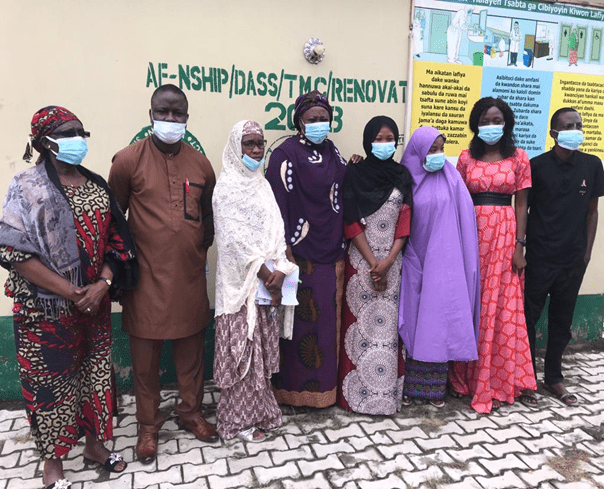Beyond Facility Level: The Role of Community Sensitization to Address Gender-Based Violence
By Helen John, WI-HER Gender, Social Inclusion, & Community Engagement Advisor in Bauchi State, Nigeria and Dr. Alhassan Siaka IHP Bauchi State Director
“At the training, we learned about the different kinds of gender-based violence, when I came back home, I did not stop my sensitization at the facility level but also began to sensitize the community through meetings.”
– Rahab Sukumya, Maternity in-charge, Dass Town PHCC, Bauchi state.

The health sector plays an instrumental role in responding to gender-based violence (GBV). Primarily, the healthcare system provides access to services, including urgent medical treatment, emergency contraception, testing and prophylaxis for HIV and sexually transmitted infections, mental health support, forensic evidence collection, and referrals for additional support and resources. As a point of entry and first line, health centers are essential resources for combating GBV, but they are reactive, providing care for the survivor after the violence has already occurred. Health centers also rely on survivors to maintain the burden of care for follow-up. However, outside of the health facilities, healthcare workers have the ability to support survivors through social channels within the community itself, which may be especially productive since providers often have social influence in the communities in which they serve. Fostering this relationship of trust between service providers and the community has been shown to positively impact social norms and behavior change globally and specifically in Nigeria it was shown, through a literature review, to positively impact community engagement with COVID-19 prevention and control.
Recognizing the need to address violence, build the clinical capacity of providers, and build trust between community and provider, the USAID Integrated Health Program (IHP) launched the GBV training and follow-up activity across all 231 healthcare facilities supported by the IHP program. Through this activity, IHP developed the capacity of 706 healthcare providers in GBV case identification, care, referral, and documentation (429 females and 277 males) across Bauchi State in 13 local government areas (LGAs) of Tafawa Balewa, Bogoro, Ningi, Darazo, Warji, Itas Gadau, Katagum, Shira, Giade, Dambam, Zaki, Gamawa, and Jama’are.
Throughout the training and follow-up, GBV sensitization and advocacy took place within the LGA leadership and in facilities. The sensitization aimed to spread awareness of GBV and the advocacy aimed to build supportive supervision for the providers’ clinical skills developed through the training, while also encouraging the integration of GBV within community-level activities. As a result, healthcare providers are utilizing the relationship they have in their respective communities to engage in community outreach and sensitization related to GBV. This provides an opportunity for communities to critically reflect on the issues related to violence in their community and on their role in preventing such violence, while also providing awareness of the services now available within the facilities.
The Dass Town Primary Healthcare Centre (PHCC) was one of the IHP-supported facilities in Bauchi State where the providers were trained on GBV identification, care, documentation, and reporting skills. In addition to the clinical facility-based activity, the providers expanded on activities within the community level. To raise local awareness and secure community support, Dass Town PHCC hosted a series of community sensitization meetings with nearly 150 participants, including traditional leaders, men, the police, and hospital staff. Following the community sensitization activity, Rahab Sukumya, the maternity in-charge at Dass Town PHCC, and providers were excited to engage in the community to increase the utilization of services at the facility. As the maternity in-charge at the PHCC, she is using her position in the facility to serve as a point person on GBV identification and care, conducting initial screening on her incoming patients in the maternity ward, while also being utilized as the in-facility referral endpoint for care. As a trusted and active member of the Dass Town community, she leveraged her personal relationships and reputation to encourage people to stand up to violence and seek services through community meetings held as information forums for health activities. In addition to the community meetings, she often will speak with her inquisitive neighbors near her home. According to her,
“At the training, we learned about the different kinds of gender-based violence. When I came back home, I did not stop my sensitization at the facility level but also began to sensitize the community through meetings.”
As a true advocate for her community, she has even taken it upon herself to strengthen coordination and hold institutions responsible.
“Based on my new skills, I was able to identify a case of intimate partner violence in my facility, and I referred her to the police but never got any feedback from her. I followed up and discovered that her case was not treated because the police said it was not within their jurisdiction. I have invited the police to one of our sensitizations so that they can better understand their role in GBV. Now, we include GBV sensitization to Islamiyya schools and outreaches and our message is simple: GBV cases should not be hidden but reported.”
Through the coordinated efforts of IHP and healthcare providers, community influencers are taking the health and safety of their communities to the next level, and the communities are being provided with GBV prevention and response for the first time. This kind of community involvement and sensitizationis important in shaping the GBV narrative. Community mobilization is a way forward for GBV prevention and response.